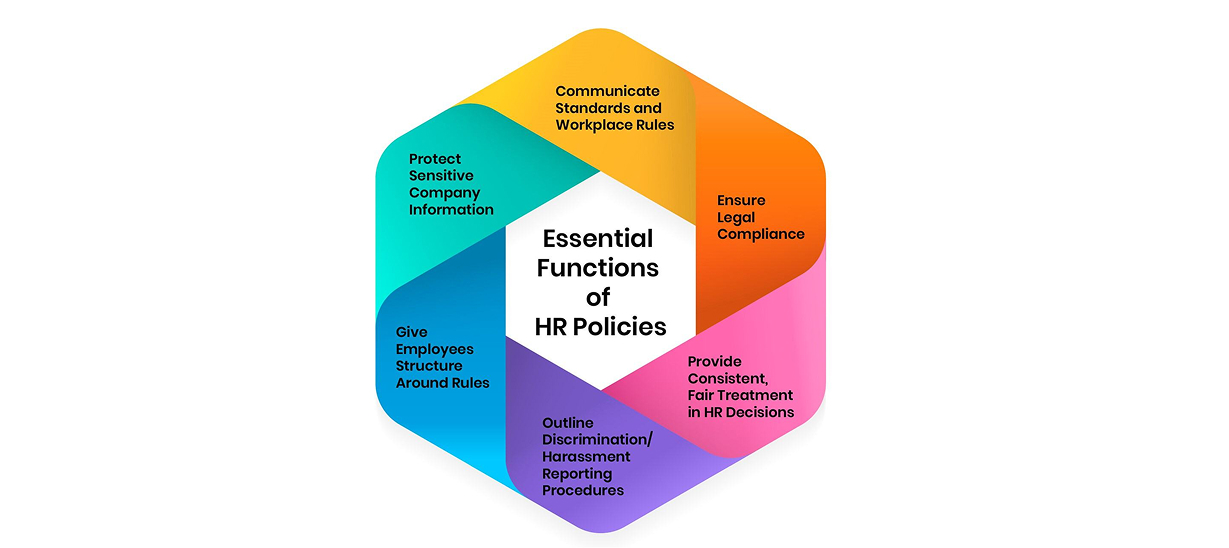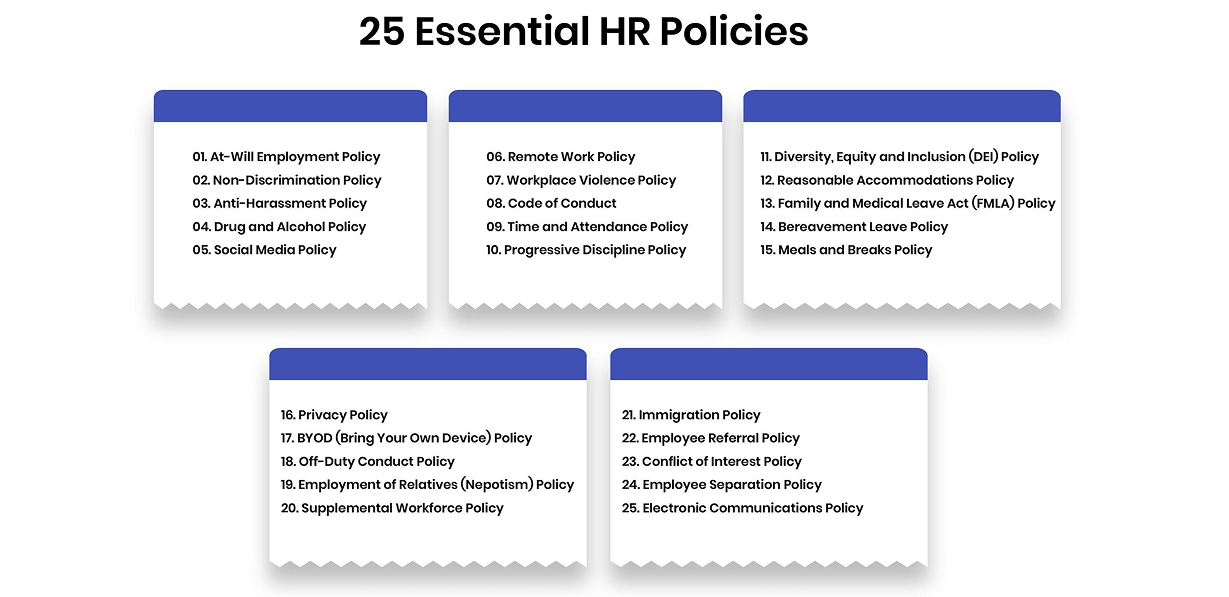
As the world of work rapidly evolves, human resources plays an increasingly vital role in helping organizations adapt policies and practices to balance employee rights with business needs.
Clear, legally-compliant HR policies outline expected codes of conduct and help ensure consistent, fair treatment of employees. They also minimize risks and misunderstandings stemming from unclear or biased guidelines around hiring, discipline, diversity, remote work, and more.
This article spotlights 25 critical HR policies that every organization should have in place for 2025 and beyond.
HR policies are formal written guidelines dictating standards and expectations around employment-related issues. They provide structure and transparency for HR managers and employees on topics like:
Well-defined policies applied consistently across an organization can help avoid misunderstandings, disputes, and even legal issues.
HR policies serve many essential functions:

A primary purpose of HR policies is to establish and communicate company standards and workplace rules. This provides clarity for employees on expectations, responsibilities, and consequences if policies are violated.
For example, a social media policy outlines proper usage of company social media accounts and acceptable conduct standards for employees’ personal accounts. Dress code and attendance policies establish norms around appropriate attire and punctuality.
Without clear policies, employees may be left to guess on basic rules and expected conduct. This causes confusion, inconsistency, and unnecessary conflicts or disciplinary issues. Clearly defined policies reinforce standards from day one.
HR policies help ensure companies comply with employment laws and regulations. There are numerous federal, state and local laws covering various aspects of HR management. These include anti-discrimination, wage and hour, family and medical leave, workplace safety and more.
If an organization lacks clear, compliant policies and consistency in administering them, it risks costly lawsuits, fines and reputational damage. For instance, inconsistent application of remote work policies could enable bias and discrimination.
HR policies aim to remove personal bias and subjectivity from employment-related processes and decisions. Without established policies, managers may make choices based on their own preferences versus objective criteria. This allows favoritism, prejudice and unfair treatment to influence hiring selections, performance reviews, promotions, terminations and more.
Studies show diversity and inclusion also suffer without standardized policies. For example, a gender neutral parental leave policy helps close gender gaps. Comprehensive anti-discrimination and anti-harassment policies also promote equal opportunities.
It is a legal requirement for companies to have clearly defined reporting procedures for discrimination, harassment and other policy violations. This enables employees to properly escalate issues for investigation without fear of retaliation.
HR must ensure that all employees are aware of their rights and know exactly where to turn if they experience or witness misconduct. This facilitates timely, appropriate handling of matters that, if left unaddressed, could spiral into toxic culture or legal liabilities.
The structure that HR policies provide around expectations helps avoid stress, penalties and lost productivity related to uncertainty. Employees may obsess over unclear attendance requirements, dress codes, work schedule flexibility and more.
With clearly defined policies, workers can focus efforts on job duties rather than interpreting vague rules. Explicit absence notification procedures, for example, prevent confusion around proper channels and documentation needs.
Policies safeguard intellectual property, trade secrets, strategies and other proprietary company information. A thorough electronic communications or social media policy details proper data and document sharing procedures, storage and ethical usage to prevent leaks.
Non-disclosure and confidentiality policies also limit information access to those who truly need it for their job. This prevents internal and external threats to critical business data and systems.
In their absence, inconsistent rules enforcement, unfair treatment, and legal violations become much more likely.
While specific policies differ across companies, these examples represent critical areas HR departments must address through clear guidelines in 2025:

This policy outlines the at-will nature of most employment relationships, where either party can terminate at any time provided there are no contractual restrictions or unlawful reasons. It provides helpful context around employment flexibility.
This policy affirms commitment to equal opportunity and prohibits discrimination or harassment based on protected classes like gender, race, age, or religion. It ensures compliance and promotes diversity/inclusion.
This is a more detailed policy outlining definitions, examples, reporting procedures and consequences specifically related to harassment in the workplace. It maintains a safe, comfortable environment.
This policy establishes rules around substance use at work, testing procedures, support programs, and disciplinary actions for violations. It ensures health, safety and productivity.
These guidelines cover appropriate vs prohibited social media usage, highlighting professionalism, confidentiality, legal issues, and consequences for violations. This protects employees and the company brand.
For a growing remote workforce, this policy addresses eligibility, expectations, etiquette, tech/equipment, and performance management. It facilitates effective virtual collaboration.
This policy defines unacceptable violent behaviors and threats, detailing reporting procedures, investigation steps, and consequences. It safeguards employees from harm.
The code of conduct sets clear expectations around ethics, integrity and professionalism for the workplace. It ensures alignment with company values and culture.
This policy provides guidance to employees and managers on punctuality, attendance tracking, paid time off accrual and requests. It maintains productivity and compliance.
This outlines the typical sequence of actions taken to address policy violations, from verbal warnings to termination. It promotes consistent, fair disciplinary procedures.
This policy affirms the value of DEI across the company through hiring, professional development, succession planning and workplace culture initiatives.
These guidelines cover the interactive process of assessing disability-related accommodation requests and implementing approved accommodations. This ensures ADA compliance.
This policy details eligibility, coverage, certification/recertification protocols and return-to-work procedures for protected medical and family leaves. It provides employees with job-protection for health/family needs.
This policy allows grieving employees dedicated paid time off to cope with the loss of a close relative. This supports mental health and work-life balance during difficult times.
This policy informs employees of meal and rest break duration and scheduling protocols in compliance with labor laws. It maintains productivity and employee wellbeing.
This provides transparency around collection and usage of employees’ personal data, ensuring ethical data practices that respect employee privacy.
With more employers allowing personal devices for work, this policy covers usage guidelines, security protocols, and support. It enables mobility while safeguarding company data.
While employers generally avoid regulating employee behavior outside of work, this policy outlines expectations around sharing internal information, interacting with media, social media postings, etc. that could impact the company.
This policy aims to prevent perceptions of favoritism through protocols like restrictions on relatives supervising one another or involvement in hiring processes.
This provides guidance on effective utilization and management of temporary/contract workers to complement the full-time workforce.
These specialized guidelines facilitate visa sponsorships, compliance training, and onboarding processes for employing foreign national talent.
This policy governs processes for employee referrals as a recruiting source, detailing eligibility, bonus structures, and avoidance of referral coercion. It taps into employee networks with proper protocols.
These guidelines prohibit employees from influencing decisions where they have a personal or financial interest. It maintains integrity and objectivity.
This policy covers voluntary resignation processes, involuntary termination protocols, exit interviews, final pay details, and consequences for failing to return company property.
This policy sets expectations around proper utilization of company communication systems including email, Internet, social media, devices, etc. It balances productivity and security.
Updating HR policies regularly is crucial as workplace dynamics, technology, and laws evolve. Core policy areas to prioritize include:
HR policies provide structure and clarity for organizations and employees navigating the modern employment landscape. By investing in comprehensive, legally compliant policies, companies empower HR departments to balance employee rights with business objectives.
The workforce landscape grows more complex each year, amplifying the need for clear policies guiding employee expectations and HR decisions. This article presented 25 examples of essential HR policies spanning ethics, compliance, technology, diversity, safety and beyond that every organization should implement in 2025 and beyond.

CredBadge™ is a proprietary, secure, digital badging platform that provides for seamless authentication and verification of credentials across digital media worldwide.
CredBadge™ powered credentials ensure that professionals can showcase and verify their qualifications and credentials across all digital platforms, and at any time, across the planet.

Please enter the License Number/Unique Credential Code of the certificant. Results will be displayed if the person holds an active credential from TMI.